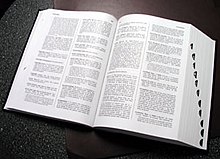Thumb index
Appearance

A thumb index, also called a cut-in index[1] or an index notch,[2] is a round cut-out in the pages of dictionaries, encyclopedias, Bibles and other large religious books, and various sectioned, often alphabetic, reference works, used to locate entries starting at a particular letter or section. The individual notches are called thumb cuts.
Several ways to achieve this indexing effect were invented and patented in the 1970s by Arthur S. Friedman, a printing engineer in New York.[3]
See also
[edit]References
[edit]- ^ "thumb index". Bookbinding and the Conservation of Books: A Dictionary of Descriptive Terminology. Foundation of the American Institute for Conservation. Retrieved 8 May 2012.
- ^ Popular Mechanics. Hearst Magazines. Sep 1956. p. 184.
- ^ "Google Patents". patents.google.com.

